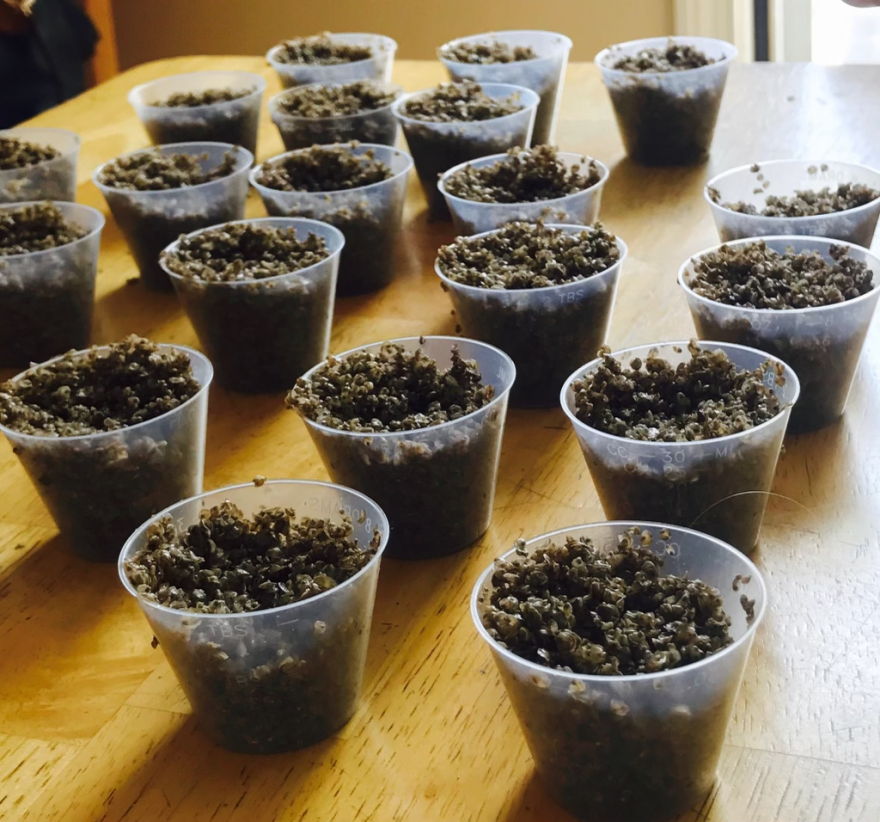Mark Begley and Greta Nelson grow oysters in Barnstable Harbor.
"All of this is Sandy Neck. It's about a seven-mile-long barrier beach. Barnstable used to have a native population of oysters maybe 100 years ago but it’s no longer," Mark said. He started the farm in 1999.
Instead today the oysters in Barnstable Harbor are farmed by aquaculture growers. Like all farmers, oyster growers have to buy seed each season. And Greta Nelson says that when their oyster seeds arrive from the hatchery, they’re tiny, so small that they can’t just be put out on the flats — they grow them in bags made of fine mesh
"So we get our seed at 2 to 3 millimeters. And so basically the nursery process with the seed is sort of a negotiation between water flow and mesh size and density with the oysters so dealing with them can be a little nerve-wracking."

Four thousand oysters at this size fit into a shot glass, and the farm orders about 400,000 baby oysters from four hatcheries each spring, partly to ensure diversity in their sources and genetics, but also aquaculture has gotten more popular over the past two decades, and seed purchasing has become somewhat competitive. Mark explains:
"Every year it seems to be starting a little earlier. And so now we're starting to get price list from the different hatcheries as early as October or November. Normally we have all of our orders in by sometime in December as opposed to ten or 20 years ago, if you got an order in in February, you were ahead of a lot of people."
The first oysters arrive on the farm sometime in June.
"The earlier the better," Mark said. "But if you try to get them too early, there's not enough food in the water. There's not enough algae drifting by for them to eat. And if you get a whole bunch early and there's no food, it's a fast way to lose all of them."
In some places on the Cape, there are still wild oyster populations that spawn and send out seed in early summer. Aquaculture growers have to try to mimic this timing, and some farms do this with the help of a sort of shellfish seed incubator called an upweller.
"So an upweller — it would typically be located at a dock or sometimes there are upwellers that are on land, if you're on a dock here in the ocean, and if you're on land, you have a water flow intake—and the oysters are in these sort of, cylindrical bins that have a mesh on the bottom, so the water is welling up from the bottom to feed the oysters to circulate the seawater. And oysters are filter feeders, so they're eating phytoplankton out of the water, and so the upwellers are sort of continually circulating that food. And for us we don’t have that, we just have the tidal cycle so we’re getting sort of fresh influx of food for the oysters as the tide is going in and out," Greta explained.
Growing out seed like this on the flats is called a field nursery, and it involves continually moving oyster seed into bigger and bigger mesh sizes. It also requires keeping an eye on seed to make sure the gear isn’t fouled with algae, and that the oysters are growing and healthy.
"Depending on the current and how things are going you can get a bunch of the little seed all bunched up and the ones in the middle of the pile so to speak don’t have much access to food and so you don’t want that to happen and so that’s why it’s important to check them weekly, or every other week," Mark said.
So it’s kind of like repotting a plant.

"It's very much like repotting a plant, except it's a whole field of plants, not just a potted plant. So it's, you know, when you're trying to deal with, you know, a shot glass with 4,000 little animals in it, that just shows you how tiny they are and how careful you have to be. They're baby oysters that have very thin little shells. And if you're rough at all with how you're handling them, you're going to end up with a very poor yield a year later" Mark said.
It takes about a year to a year and a half for baby oyster seed, or spat, to grow big enough to bring to market. This year’s seed will go out onto the flats in June or early July and before we know it, we’ll be eating them on the halfshell.
—
Here's a link to learn more about northeast shellfish hatcheries: https://www.mass.gov/service-details/find-an-approved-shellfish-seed-hatchery
Here's a link to learn more about local field nursery options as alternatives to upwelling for small oyster seed: https://seagrant.whoi.edu/wp-content/uploads/2022/12/Small-seed-Marine-Extension-Bulletin_12-1-2022.pdf








